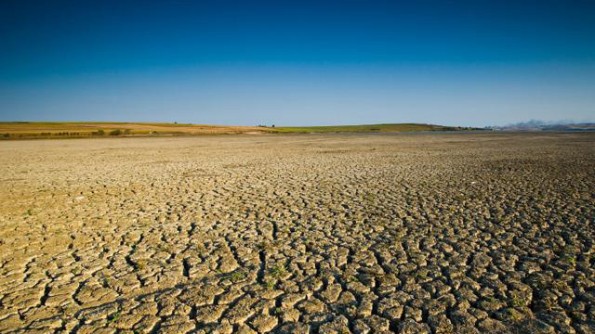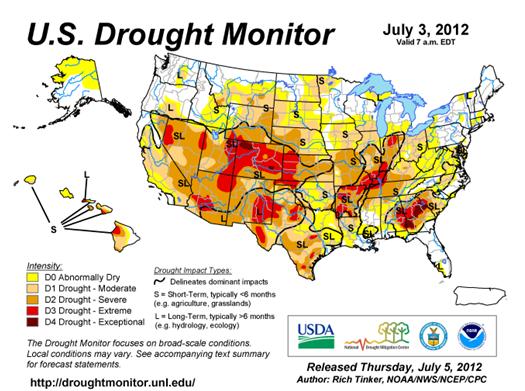Record breaking expanse of drought across US

46.84 percent of the US land area is in various stages of drought, up from 42.8 percent a week ago. Previous records were 45.87 percent in drought on Aug. 26, 2003, and 45.64 percent on Sept. 10, 2002.
Looking only at the 48 contiguous states, 55.96 percent of the country’s land area is in moderate drought or worse – also the highest percentage on record in that regard, officials said. The previous highs had been 54.79 percent on Aug. 26, 2003, and 54.63 percent on Sept. 10, 2002.
“The recent heat and dryness is catching up with us on a national scale,” said Michael J. Hayes, director of the National Drought Mitigation Center at UNL. “Now, we have a larger section of the country in these lesser categories of drought than we’ve previously experienced in the history of the Drought Monitor.”

The monitor uses a ranking system that begins at D0 (abnormal dryness) and moves through D1 (moderate drought), D2 (severe drought), D3 (extreme drought) and D4 (exceptional drought).
Moderate drought’s telltale signs are some damage to crops and pastures, with streams, reservoirs or wells getting low. At the other end of the scale, exceptional drought includes widespread crop and pasture losses, as well as shortages of water in reservoirs, streams and wells, creating water emergencies. So far, just 8.64 percent of the country is in either extreme or exceptional drought.
“During 2002 and 2003, there were several very significant droughts taking place that had a much greater areal coverage of the more severe and extreme drought categories,” Hayes said. “Right now we are seeing pockets of more severe drought, but it is spread out over different parts of the country.
“It’s early in the season, though. The potential development is something we will be watching.”
Extreme drought reported for Alabama and Arkansas
The abnormally dry conditions gripping Alabama now cover more than 90 percent of the state. An analysis released Thursday, July 5, 2012 by the U.S. Drought Monitor shows southwest Alabama is the only section of the state that’s not experiencing a large rainfall deficit.
The situation is worst in eastern Alabama, where all but a few counties are in a severe or extreme drought. Arid conditions are classified as exceptionally bad in parts of Barbour and Henry counties in the state’s southeastern corner. In all, about 91 percent of the state is either abnormally dry or in a full-blown drought.
Forestry officials say there’s an increased threat of wildfires because of the dry conditions, and farmers are having on irrigation to sustain crops in many areas.
The latest drought report says more than a third of Arkansas is in extreme drought conditions. The U.S. Drought Monitor report says all of Arkansas is undergoing drought conditions.
A handful of counties are experiencing moderate drought conditions, but most of Arkansas is either in severe or extreme drought. Northern counties from Carroll to Clay and extending south to Jackson are in extreme drought, as is southwest Arkansas.
A pocket of north central Arkansas counties from Franklin to Conway and Van Buren counties is also classified as extreme. The National Weather Service says rain is possible this weekend and early next week, but it will likely have little impact on the drought conditions.
Next several days in US
In general, July 4 – 8, 2012 doesn’t look promising in terms of relief, though the intense heat should subside somewhat. One area that could see relief would be from the central and southern Rockies into the northern Plains, much of which is forecast to receive over an inch of rain. Totals near or above 2 inches are expected in the central Dakotas. One to perhaps 3 inches are also anticipated along and near the central Gulf Coast.
Elsewhere, light rain at best is expected, with little or none forecast for the lower Northeast, the mid-Atlantic region, the upper Southeast, the Ohio Valley, much of the Mississippi Valley, and the central and southern Plains. Seasonably dry weather is expected in the West.
Modest improvement is forecast for most areas that have endured the recent heat wave, but most locations from the Plains eastward are still expected to be warmer than normal. Temperatures could average over 6 degrees above normal from the mid-Atlantic region westward through the Tennessee and Ohio Valleys to near the Mississippi River.
The ensuing 5 days (July 9 – 13, 2012) bring enhanced chances for below-normal rainfall from the Tennessee and middle Mississippi Valleys northward through the Appalachians, Great Lakes, and northern Great Plains. In contrast, the odds favor above-normal rainfall along and near the southern half of the Atlantic Coast and in the southern halves of the High Plains and Rockies. Below-normal temperatures are expected to settle into the Northeast, but continued above-normal temperatures are anticipated in the southern halves of the Mississippi Valley and eastern Plains, and from the northern Plains, the central Rockies, and the desert Southwest westward to near the Pacific Coast.
Drought Monitor: droughtmonitor.unl.edu
Sources: droughtmonitor, phys.org, RSOE

Co2 DOES NOT cause drought. Stop swallowing the elitist propaganda! Much of the global warming debate has focused on reducing CO2 emissions because it is thought that the greenhouse gas produced mostly from fossil fuels is warming the planet. But if one cares to do a little honest research, (outside of lamestream media propaganda) there is mountain of studies and scientific evidence that suggest CO2 is not the cause for warming. What’s more, CO2 levels are so low that more, not less, is needed to sustain and expand plant growth. if CO2 levels are cut, food production will slow because plants grown at higher CO2 levels make larger fruit and vegetables and also use less water. CO2 levels are not harmful to humans. As an example, Earth’s atmosphere currently has about 338 parts per million of CO2 and that in Navy subs, the danger level for carbon dioxide isn’t reached until the air has 8,000 parts per million of CO2. The problem with this debate is that the news media do not publish the 100,000 years data on temperature cycles, do not publish and show that every season has straight line trends not curved upwards trends, politicians are uninformed, many scientists are lazy and only quote there are 200 reports that say CO2 causes global warming when 10’s of thousands of scientists say these reports are self-deserving, only based in simulations not real data, and are wrong. Thus, we have ignorant and uninformed people spouting off with virulent bursts of angry statements but no reasoned facts to support their views. People, do your homework, and insist the media do theirs.
Congress is FIDDLING WHILE AMERICA IS BURNING! Congress knows Co2 in the Jet Stream and Atmosphere, is creating this Disaster, But they rather protect the Airline & Oil Industries, Than save the planet. The only way to handle this is for the Farmers to sue these Industries, to get Action.
This statement is just not true. “Previous records were 45.87 percent in drought on Aug. 26, 2003, and 45.64 percent on Sept. 10, 2002.”
The current drought conditions are nothing in comparison to the 1930s “Dust Bowl” years.
The decade started with dry years in 1930 and 1931 especially in the East. Then, 1934 recorded extremely dry conditions over almost 80 percent of the United States. Extreme drought conditions returned in 1936, 1939 and 1940.
During this period, schools were closed for dust storms vice for snow.
Just found “thewatchers” web site and am glad to have done so great information. The ever worsening global drought will continue so long as SAG (stratospheric aerosol geoengineering) and SRM (solar radiation management) continue. Geoengineering (aka chemtrails) are the largest single cause for global drought. Any that take the time to investigate this will find a mountain of science to back up this claim. Current articles addressing the drought causing effects of geoengineering on the web site “geoengineeringwatch.org”